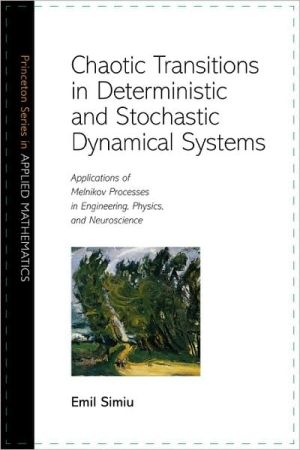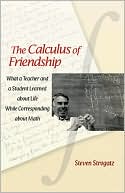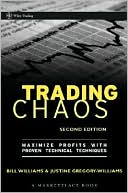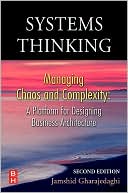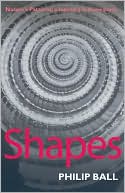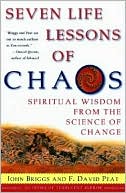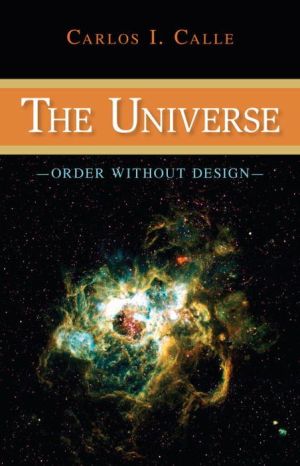Chaotic Transitions in Deterministic and Stochastic Dynamical Systems: Applications of Melnikov Processes in Engineering, Physics, and Neuroscience
The classical Melnikov method provides information on the behavior of deterministic planar systems that may exhibit transitions, i.e. escapes from and captures into preferred regions of phase space. This book develops a unified treatment of deterministic and stochastic systems that extends the applicability of the Melnikov method to physically realizable stochastic planar systems with additive, state-dependent, white, colored, or dichotomous noise. The extended Melnikov method yields the...
Search in google:
"The author has chosen an excellent subject, which will probably become a main direction of research in the field of stochastic differential equations. This book is addressed to a wide readership: specialists in dynamical systems and stochastic processes, mathematicians, engineers, physicists, and neuroscientists. The author succeeds in making the material interesting to all these groups of researchers."—Florin Diacu, Pacific Institute for the Mathematical Sciences, University of Victoria Daniel ben-Avraham - Journal of Statistical Physics Highly readable, elegant, and concise. . . . Emil Simiu has succeeded in putting together a highly stimulating book that proposes a promising, unifying approach to various aspects of chaos theory. While encompassing a wide swath of topics, traditionally found only on scattered sources, the book is succinctly written, exhibiting a quality reserved to the best of review works.
COPYRIGHT NOTICE: Published by Princeton University Press and copyrighted, © 2002, by Princeton University Press. All rights reserved. No part of this book may be reproduced in any form by any electronic or mechanical means (including photocopying, recording, or information storage and retrieval) without permission in writing from the publisher, except for reading and browsing via the World Wide Web. Users are not permitted to mount this file on any network servers.\ Chapter One\ Introduction\ This work has two main objectives: (1) to present the Melnikov method as a unified theoretical framework for the study of transitions and chaos in a wide class of deterministic and stochastic nonlinear planar systems, and (2) to demonstrate the method's usefulness in applications, particularly for stochastic systems. Our interest in the Melnikov method is motivated by its capability to provide criteria and information on the occurrence of transitions and chaotic behavior in a wide variety of systems in engineering, physics, and the life sciences.\ To illustrate the type of problem to which the Melnikov method is applicable we consider a celebrated experiment on a system known as the magne-toelastic beam. The experiment demonstrates the remarkable type of dynamic behavior called deterministic chaos (Moon and Holmes, 1979). The system consists of (a) a rigid frame fixed onto a shaking table that may undergo periodic horizontal motions, (b) a beam with a vertical undeformed axis, an upper end fixed onto the frame, and a free lower end, and (c) two identical magnets equidistant fromthe undeformed position of the beam (Fig. 1.1). The beam experiences nonlinear displacement-dependent forces induced by the magnets, linear restoring forces due to its elasticity, dissipative forces due to its internal friction, the viscosity of the surrounding air, and magnetic damping, and periodic excitation forces due to the horizontal motion of the shaking table. Neither the system properties nor the forces acting on the beam vary randomly with time: the system is fully deterministic.\ In the absence of excitation, and depending upon the initial conditions, the beam settles on one of two possible stable equilibria, that is, with the beam's tip closer to the right magnet or closer to the left magnet. The beam also has an unstable equilibrium position—its vertical undeformed axis.\ If the excitation is periodic, three distinct types of steady-state dynamic behavior can occur:\ \ \ For sufficiently small excitations, depending again upon the initial conditions, the beam moves periodically about one of its two stable equilibria. The periodic motion is confined to a half-plane bounded by the beam's unstable equilibrium position [Fig. 1.2(a)]; in this type of motion there can be no escape from that half-plane.\ \ \ \ For sufficiently large excitations the motion is periodic about—and crosses periodically—the unstable equilibrium position [Fig. 1.2(b)].\ \ \ \ For intermediate excitation amplitudes, and for restricted sets of initial conditions and excitation frequencies, the steady-state motion is irregular, even though the system is fully deterministic; hence the term deterministic chaos. The motion evolves about one of the three equilibria, then it undergoes successive transitions, that is, it changes successively to motion about one of the other two equilibria (Fig. 1.2(c)). Transitions in such irregular, deterministic motion are referred to as chaotic. A transition away from motion in a half-plane bounded by the beam's unstable equilibrium position is called an escape. A transition to motion occurring within such a half-plane is called a capture. A succession of escapes and captures is referred to as hopping.\ \ \ \ The system just described may be modeled as a dynamical system—a system that evolves in time in accordance with a specified mathematical expression. In this book we are primarily concerned with dynamical systems capable of exhibiting all three types of behavior illustrated in Fig. 1.2. One basic feature of such systems is that they are multistable, meaning that their unforced counterparts have at least two stable equilibria (the term applied to the case of two stable equilibria is bistable). In the particular case of mechanical systems, the dynamic behavior is modeled by nonlinear differential equations expressing a relationship among terms that represent\ \ \ inertial forces\ \ \ \ dissipative forces\ \ \ \ potential forces, that is, forces derived from a potential function and dependent solely upon displacements; for Fig. 1.1 these forces are due to the magnets and the elasticity of the beam\ \ \ \ excitation forces dependent explicitly on time\ \ \ \ Similar terms occur in equations modeling other types of dynamical system, for example, electrical, thermal, or chemical systems.\ For a large number of systems arising in engineering or physics safe operation requires that steady-state motions occur within a restricted region, called a safe region (in Fig. 1.2(a), the displacement coordinates in the restricted regions are bounded by the vertical line that coincides with the axis of the undeformed beam); transitions to motions visiting another region are undesirable. However, for some systems (e.g., systems that enhance heat transfer, and neurological systems whose activity entails escapes or, in neurological terminology, firings) the occurrence of such transitions is a functional requirement.\ Although we will also examine systems with a slowly varying third variable, our main focus will be on planar systems, that is, continuous systems with two time-dependent variables, for example, displacement and velocity. For planar systems subjected to periodic excitation an analytical condition that guarantees the nonoccurrence of transitions was derived in a seminal paper by Melnikov (1963). That condition involves a function—the Melnikov function—consisting of a sum of terms related, through the system's potential, to the system dissipation and excitation. The Melnikov condition for nonoccurrence of transitions states that if the Melnikov function has no zeros or at most a double zero, then transitions cannot occur. The counterpart of that condition, where the Melnikov function has simple zeros, is referred to as the Melnikov necessary condition for the occurrence of transitions. Melnikov theory requires that the perturbation—that is, the excitation and dissipation—be sufficiently small. Numerical calculations show, however, that the theory is useful for perturbations large enough to be of interest in a wide variety of applications.\ Melnikov was motivated by problems arising in nuclear physics and engineering (e.g., the theory of particle accelerators, controlled thermonuclear reactions). However, his condition has subsequently found application in a wide variety of disciplines. Examples of applications, some of which are reviewed in subsequent chapters, include\ \ \ electronic devices such as the Josephson junction (Genchev, Ivanov, and Todorov, 1983)—see Section 2.4\ \ \ \ ships—for which the roll angle must not exceed the value beyond which capsizing occurs (Falzarano, Shaw, and Troesch, 1992)\ \ \ \ transversely excited buckled columns, which may experience snap-through, that is, motion across the column's undeformed axis (Holmes and Marsden, 1981)\ \ \ \ counter-rotating eccentric cylinders with near-parallel lubricating flow, in which heat transfer is enhanced by chaotic behavior (Ghosh, Chang, and Sen, 1992)\ \ \ \ ocean flows induced by fluctuating wind along a continental shelf with corrugated floor (Allen, Samelson, and Newberger, 1991)\ \ \ \ systems for which control forces are used to suppress or modify the onset of chaotic motions (Lima and Pettini, 1990; Cicogna and Fronzoni, 1993)\ \ \ \ modulations for forcing a phased-locked loop FM demodulator circuit into chaotic behavior (Booker and Smith, 1999, Bishop and Thompson, 1999)\ \ \ \ The Melnikov method consists of the application, in various forms, of the necessary Melnikov condition for the occurrence of transitions. So far we have mentioned Melnikov's original method which, as indicated earlier, was restricted to periodically excited planar systems. The extension of the Melnikov method to planar systems with nonperiodic excitation is of interest. For deterministic systems with quasiperiodic excitation (i.e., excitation consisting of a sum of harmonics with, in general, incommensurate frequencies) the extension was developed by Wiggins (1988).\ The extension to stochastic systems was introduced by Frey and Simiu (1993). It is referred to as the stochastic Melnikov method—Melnikov's method applied to stochastic dynamical systems. The stochastic counterpart of the Melnikov function is referred to as a Melnikov process.\ For systems whose stochastic excitations are bounded the stochastic Melnikov method is a straightforward extension of the original Melnikov method. Systems excited by dichotomous noise, which are of interest in electrical engineering and chemical physics, are one example. However, for systems whose stochastic excitations are modeled by unbounded processes the Melnikov method cannot be used to guarantee the nonoccurrence of escapes. Rather, it can be used to calculate lower bounds for probabilities that transitions will not occur during specified time intervals, or upper bounds for probabilities that motion with transitions can occur.\ Melnikov (1963) had noted that, depending upon whether it has or does not have simple zeros, the function he developed can be associated with distinct types of dynamic behavior. However, he obtained his original results too early in the development of the theory of chaotic dynamics to describe one of those types of behavior as deterministic chaos. It has been known for several decades that, for deterministic planar multistable systems, the condition that the Melnikov function have simple zeros is necessary for the occurrence not only of transitions but of chaotic behavior as well (see Chapter 3). In fact, for such systems, motions with transitions occur if and only if the motion is chaotic. However, that motions with transitions occurring in stochastic planar multistable systems are also chaotic has only been established relatively recently (see Chapter 5).\ The following feature of the Melnikov method is especially useful in applications. Through the Melnikov scale factor—a function of frequency that depends upon the system's potential—the Melnikov method provides useful information on the relative degree to which the various frequency components of the excitation are effective in promoting transitions. We discuss in this book several applications of this feature, including\ \ \ Efficient control strategies for reducing the probability of stochastically induced escapes. By using information inherent in the Melnikov scale factor it is possible to devise control systems ensuring that most of the control system's energy is spent on counteracting excitation components that promote escapes effectively. In the absence of such information much or in some instances most of the energy would be wasted on counteracting excitation components that contribute negligibly to the promotion of escapes.\ \ \ \ Models of stochastic systems whose observed motions exhibit chaotic transitions. An interesting neurophysiological application is the modeling of the auditory nerve fiber. Melnikov-based models yield good agreement with experimental observations of behavior induced by periodic, quasiperiodic, and broadband white noise excitation, including observations that the classical Fitzhugh-Nagumo model appears to reproduce incorrectly. They also reveal that the dynamics of the auditory nerve fiber is chaotic.\ \ \ \ Stochastic resonance. This designates the phenomenon wherein, for signals contaminated by noise, the signal-to-noise ratio can under certain conditions be improved by the apparently paradoxical means of increasing the noise. An interpretation of stochastic resonance based on stochastic Melnikov theory shows that this phenomenon is chaotic, and explains in a transparent fashion the role of the frequency distribution of the noise in the enhancement of the signal-to-noise ratio. That interpretation also leads naturally to extending the framework of stochastic resonance, which can be shown to include the enhancement of the signal-to-noise ratio not only through the addition of noise excitation, but also through the addition of a harmonic excitation, a means that under certain conditions can be considerably more effective.\ \ \ \ Following this Introduction, the book is divided into two parts. Part 1, containing Chapters 2 through 5 is devoted to fundamentals. Part 2, containing Chapters 6 through 12, includes applications. In Chapter 2 we introduce basic elements of the theory of nonlinear dynamical systems needed for the development of the Melnikov method. We then present the derivation of the Melnikov function and the Melnikov necessary condition for the occurrence of transitions. For a particular type of system we interpret this condition from an energy viewpoint. We discuss two useful tools that simplify the study and facilitate the diagnosis of motions in continuous dynamical systems: the Poincaré section, which is applicable to periodically excited systems, and the phase space slice, which is the counterpart of the Poincaré section for quasiperiodically excited systems. We introduce the notion of transport associated with transitions, and a useful measure of the transport, the Melnikov functional known as the phase space flux factor. Finally, for the case of slowly varying planar systems, we present the derivation of the Melnikov function and the associated necessary condition for the occurrence of transitions, and note a shortcoming of the Melnikov approach with respect to the case of planar systems with no slowly varying parameter.\ In Chapter 3 we establish that motions with transitions—motions for whose occurrence it is necessary that the Melnikov function have simple zeros—are chaotic. As a first step we provide introductory definitions and illustrations of Cantor sets and fractal dimensions. We then study Smale's famous horseshoe map and the shift map, and show the equivalence of the dynamics induced by these two maps. We introduce simple symbolic dynamics techniques and apply them to the shift map to prove that its behavior is chaotic. This establishes that the equivalent dynamics induced by the Smale horseshoe map is chaotic as well. We define chaos mathematically and show that its properties include sensitivity to initial condition and fractal dimensions of geometrical structures associated with the motion, a property that is readily identifiable in certain types of numerical simulations and can therefore serve as a helpful indicator of deterministic chaos. We then state the Smale-Birkhoff theorem, which establishes that the dynamics of motions with transitions in planar multistable systems is chaotic by showing that it is equivalent to the chaotic dynamics induced by the Smale horseshoe map. We provide illustrative numerical examples and examples of chaotic motions of an experimental system, the buckled Stoker column.\ In Chapter 4 we present simple elements of the theory of stochastic processes needed for the subsequent development of the stochastic Melnikov method. In particular, we define stationary stochastic processes, autocovari-ance and cross-covariance functions, spectral densities, linear filters, convolutions, and transfer functions. We also derive the relation between the spectral density of the output and the spectral density of the input of a linear filter with known transfer function. (A brief review of basic elements of probability theory is presented in Appendix A5.)\ In Chapter 5 we develop the stochastic Melnikov method. We show that, like deterministic systems, multistable planar systems with stochastic excitation can exhibit motions with transitions that are in practice indistinguishable from deterministic chaotic motions and, like the latter, are sensitive to initial conditions. We refer to such motions as chaotic stochastic motions, as distinct from stochastic motions that do not exhibit properties associated with chaos. The applicability of the Melnikov method to stochastic systems is demonstrated by approximating the stochastic excitation processes by ensembles of sums of periodic terms, thus reducing the core of the stochastic Melnikov method to the problem, studied in Chapters 3 and 4, of the Melnikov method as applied to systems with periodic or quasiperiodic excitation. By using the stochastic Melnikov method we develop criteria that guarantee the nonoc-currence of transitions in systems excited by dichotomous noise, and simple assessments of the influence of the excitation's spectral shape on the system's escape rate.\ We now list the applications of the Melnikov method contained in Part 2. Chapter 6 describes an application to a topic in naval architecture: the capsizing problem for a rolling vessel under the action of wave forces. Chapter 7 describes the application of the Melnikov method to open-loop control. Chapter 8 uses the Melnikov method to interpret the stochastic resonance phenomenon in chaotic dynamics terms and presents useful results that follow from this interpretation. Chapter 9 describes the use of the Melnikov method for determining the cutoff point for excitation by experimental noise in a one-dimensional nonlinear system. Chapter 10 presents a study of a mechanical engineering problem: the snap-through of a buckled column excited by a transverse stochastic loading. Chapter 11 describes an application to a topic in oceanography: the problem of transitions for wind-induced along-shore currents over corrugated bottom topography. Chapter 12 describes an application of the Melnikov method in neurophysiology: the modeling of the behavior of the auditory nerve fiber as a chaotic dynamical system.
PrefaceCh. 1Introduction1Ch. 2Transitions in Deterministic Systems and the Melnikov Function112.1Flows and Fixed Points. Integrable Systems. Maps: Fixed and Periodic Points132.2Homoclinic and Heteroclinic Orbits, Stable and Unstable Manifolds202.3Stable and Unstable Manifolds in the Three-Dimensional Phase Space [X[subscript 1], X[subscript 2], t]232.4The Melnikov Function272.5Melnikov Functions for Special Types of Perturbation. Melnikov Scale Factor292.6Condition for the Intersection of Stable and Unstable Manifolds. Interpretation from a System Energy Viewpoint362.7Poincare Maps, Phase Space Slices, and Phase Space Flux382.8Slowly Varying Systems45Ch. 3Chaos in Deterministic Systems and the Melnikov Function513.1Sensitivity to Initial Conditions and Lyapounov Exponents. Attractors and Basins of Attraction523.2Cantor Sets. Fractal Dimensions573.3The Smale Horseshoe Map and the Shift Map593.4Symbolic Dynamics. Properties of the Space [Sigma][subscript 2], Sensitivity to Initial Conditions of the Smale Horseshoe Map. Mathematical Definition of Chaos653.5Smale-Birkhoff Theorem. Melnikov Necessary Condition for Chaos. Transient and Steady-State Chaos673.6Chaotic Dynamics in Planar Systems with a Slowly Varying Parameter703.7Chaos in an Experimental System: The Stoker Column71Ch. 4Stochastic Processes764.1Spectral Density, Autocovariance, Cross-Covariance764.2Approximate Representations of Stochastic Processes874.3Spectral Density of the Output of a Linear Filter with Stochastic Input94Ch. 5Chaotic Transitions in Stochastic Dynamical Systems and the Melnikov Process985.1Behavior of a Fluidelastic Oscillator with Escapes: Experimental and Numerical Results1005.2Systems with Additive and Multiplicative Gaussian Noise: Melnikov Processes and Chaotic Behavior1025.3Phase Space Flux1065.4Condition Guaranteeing Nonoccurrence of Escapes in Systems Excited by Finite-Tailed Stochastic Processes. Example: Dichotomous Noise1095.5Melnikov-Based Lower Bounds for Mean Escape Time and for Probability of Nonoccurrence of Escapes during a Specified Time Interval1125.6Effective Melnikov Frequencies and Mean Escape Time1195.7Slowly Varying Planar Systems1225.8Spectrum of a Stochastically Forced Oscillator: Comparison between Fokker-Planck and Melnikov-Based Approaches122Ch. 6Vessel Capsizing1296.1Model for Vessel Roll Dynamics in Random Seas1296.2Numerical Example132Ch. 7Open-Loop Control of Escapes in Stochastically Excited Systems1347.1Open-Loop Control Based on the Shape of the Melnikov Scale Factor1347.2Phase Space Flux Approach to Control of Escapes Induced by Stochastic Excitation140Ch. 8Stochastic Resonance1448.1Definition and Underlying Physical Mechanism of Stochastic Resonance. Application of the Melnikov Approach1458.2Dynamical Systems and Melnikov Necessary Condition for Chaos1468.3Signal-to-Noise Ratio Enhancement for a Bistable Deterministic System1478.4Noise Spectrum Effect on Signal-to-Noise Ratio for Classical Stochastic Resonance1498.5System with Harmonic Signal and Noise: Signal-to-Noise Ratio Enhancement through the Addition of a Harmonic Excitation1528.6Nonlinear Transducing Device for Enhancing Signal-to-Noise Ratio1538.7Concluding Remarks155Ch. 9Cutoff Frequency of Experimentally Generated Noise for a First-Order Dynamical System1569.1Introduction1569.2Transformed Equation Excited by White Noise157Ch. 10Snap-Through of Transversely Excited Buckled Column15910.1Equation of Motion16010.2Harmonic Forcing16110.3Stochastic Forcing. Nonresonance Conditions. Melnikov Processes for Gaussian and Dichotomous Noise16310.4Numerical Example164Ch. 11Wind-Induced Along-Shore Currents over a Corrugated Ocean Floor16711.1Offshore Flow Model16811.2Wind Velocity Fluctuations and Wind Stresses17011.3Dynamics of Unperturbed System17211.4Dynamics of Perturbed System17311.5Numerical Example174Ch. 12The Auditory Nerve Fiber as a Chaotic Dynamical System17812.1Experimental Neurophysiological Results17912.2Results of Simulations Based on the Fitzhugh-Nagumo Model. Comparison with Experimental Results18212.3Asymmetric Bistable Model of Auditory Nerve Fiber Response18312.4Numerical Simulations18612.5Concluding Remarks190App. A1Derivation of Expression for the Melnikov Function191App. A2Construction of Phase Space Slice through Stable and Unstable Manifolds193App. A3Topological Conjugacy199App. A4Properties of Space [Sigma][subscript 2]201App. A5Elements of Probability Theory203App. A6Mean Upcrossing Rate [tau][subscript u][superscript -1] for Gaussian Processes211App. A7Mean Escape Rate [tau][subscript [epsilon]][superscript -1] for Systems Excited by White Noise213References215Index221
\ Journal of Statistical Physics\ - Daniel ben-Avraham\ Highly readable, elegant, and concise. . . . Emil Simiu has succeeded in putting together a highly stimulating book that proposes a promising, unifying approach to various aspects of chaos theory. While encompassing a wide swath of topics, traditionally found only on scattered sources, the book is succinctly written, exhibiting a quality reserved to the best of review works.\ \ \ \ \ Journal of Statistical PhysicsHighly readable, elegant, and concise. . . . Emil Simiu has succeeded in putting together a highly stimulating book that proposes a promising, unifying approach to various aspects of chaos theory. While encompassing a wide swath of topics, traditionally found only on scattered sources, the book is succinctly written, exhibiting a quality reserved to the best of review works.\ — Daniel ben-Avraham\ \
